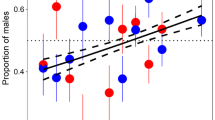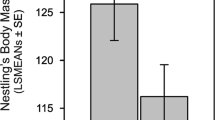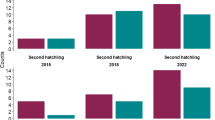Abstract
In birds, possible explanations for a bias in brood sex ratio include differential cost of rearing nestlings of different sexes, and different parental fitness returns related to offspring sex. We studied brood sex ratio of Magellanic penguins, Spheniscus magellanicus, in Puerto Deseado for 3 years. Our objectives were to compare the growth curves and energetic costs of rearing nestlings of different sexes, and to evaluate the possible implications of environmental and parental condition in the establishment of a bias in the brood sex ratio. We also investigated the relationship between hatching order and sex, and its impact on brood survival. Asymptotic mass was 11.41% higher for males than for females. The energetic cost of feeding male nestlings was slightly higher than for feeding females, but the difference in energy requirements was only 2.6% of the total energy budget. During the 3 years, brood sex ratio was 0.53, and almost constant within years over the raising period, showing no sex allocation during feeding. Sea surface temperature, which is linked to higher prey abundance when colder, explained brood sex ratio at fledging. The sex ratio was male-biased during the coldest year. Parental body condition was not an important variable explaining brood sex ratio. There was no bias in nestling sex with respect to hatching order and nestling survival was not related to nestling sex. We conclude that, even though the cost of feeding male offspring is higher, it only involves a small fraction of total cost of raising nestlings and might not be responsible for an adaptive bias in the sex ratio of nestlings for this species. However, during good oceanic conditions, females might bias their brood sex ratio towards males, thereby potentially gaining an advantage by raising good-quality males.



Similar content being viewed by others
Availability of data and material
The datasets generated during and/or analysed during the current study are available from the corresponding author on reasonable request.
References
Addison B, Kitaysky AS, Hipfner JM (2008) Sex allocation in a monomorphic seabird with a single-egg clutch: test of the environment, mate quality, and female condition hypotheses. Behav Ecol Sociobiol 63(1):135–141
Amundsen T, Slagsvold T (1991) Asynchronous hatching in the pied flycatcher: an experiment. Ecology 72:797–804
Amundsen T, Slagsvold T (1996) Lack’s brood reduction hypothesis and avian hatching asynchrony: what’s next? Oikos 76:613–620
Barrionuevo M (2015) Inversión parental en el Pingüino de Magallanes (Spheniscus magellanicus): asincronía de eclosión, causas próximas y últimas. PhD Thesis, UBA, Argentina
Barrionuevo M, Frere E (2014) Parental investment in eggs and its effect on nestling growth and survival in Magellanic penguins. Emu-Austral Ornithol 114(3):259–267
Barrionuevo M, Frere E (2017) An experimental approach to the brood reduction hypothesis in Magellanic penguins. J Avian Biol 48:1077–1086
Barrionuevo M, Ciancio J, Marchisio N, Frere E (2018) Parental body condition and high energy value of fish determine nestling success in Magellanic penguin (Spheniscus magellanicus). Mar Biol 165(6):105
Barrionuevo M, Ciancio J, Steinfurth A, Frere E (2020) Geolocation and stable isotopes indicate habitat segregation between sexes in Magellanic penguins during the winter dispersion. J Avian Biol. https://doi.org/10.1111/jav.02325
Bates D, Maechler M, Bolker B, Walker S, Christensen RHB, Singmann H, Dai B, Scheipl F, Grothendieck G, Green P, Fox J (2018) Package ‘lme4.’ Version 1:17
Behrenfeld MJ, O’Malley RT, Siegel DA, McClain CR, Sarmiento JL, Feldman GC, Milligan AJ, Falkowski PG, Letelier RM, Boss ES (2006) Climate-driven trends in contemporary ocean productivity. Nature 444(7120):752–755
Bertellotti M, Tella JL, Godoy JA, Blanco G, Forero MG, Donázar JA, Ceballos O (2002) Determining sex of Magellanic penguins using molecular procedures and discriminant functions. Waterbirds 25:479–485
Boersma PD (2008) Penguins as marine sentinels. Bioscience 58:597–607
Boersma PD, Stokes DL, Yorio PM (1990) Reproductive variability and historical change of Magellanic penguins (Spheniscus magellanicus) at Punta Tombo, Argentina. In: Davis L, Darby J (eds) Penguin biology. Academic Press, California, pp 15–43
Boersma PD, Rebstock GA, Frere E, Moore SE (2009) Following the fish: penguins and productivity in the South Atlantic. Ecol Monogr 79:59–76
Boersma PD, Frere E, Kane O, Pozzi LM, Pütz K, Raya Rey A, Rebstock GA, Simeone A, Smith J, Van Buren A, Yorio P, Garcia-Borboroglu P (2013) Magellanic penguin (Spheniscus magellanicus). In: Borboroglu PG, Boersma PD (eds) Penguins: natural history and conservation. University of Washington Press, Washington, pp 233–263
Bortolotti GR (1986) Influence of sibling competition on nestling sex ratios of sexually dimorphic birds. Am Nat 127:495–507
Brown CR (1987) Energy requirements for growth and maintenance in macaroni and rockhopper penguins. Polar Biol 8:95–102
Ciancio JE, Pascual MA, Beauchamp DA (2007) Energy density of Patagonian aquatic organisms and empirical predictions based on water content. Trans Am Fish Soc 136:1415–1422
Ciancio JE, Quintana F, Sala JE, Wilson RP (2016) Cold birds under pressure: can thermal substitution ease heat loss in diving penguins? Mar Biol 163(2):43
Clutton-Brock TH, Albon SD, Guinness FE (1981) Parental investment in male and female offspring in polygynous mammals. Nature 289(5797):487–489
Cockburn A, Legge S, Double MC (2002) Sex ratios in birds and mammals: can the hypotheses be disentangled. In: Hardy ICW (ed) Sex ratios: concepts and research methods. Cambridge University Press, pp 266–286
Dehnhard N, Poisbleau M, Demongin L, Ludynia K, Lecoq M, Masello JF, Quillfeldt P (2013) Survival of rockhopper penguins in times of global climate change. Aquat Conserv Mar Freshwat Ecosyst 23(5):777–789
Emlen ST, Oring LW (1977) Ecology, sexual selection, and the evolution of mating systems. Science 197:215–223
Fargallo JA, Davila JA, Potti J, De Leon A, Polo V (2004) Nest size and hatchling sex ratio in chinstrap penguins. Polar Biol 27:339–343
Fisher RA (1930) The genetical theory of natural selection. Oxford University Press, Oxford
Fogliarini CDO, Bugoni L, Haimovici M, Secchi ER, Cardoso LG (2019) High mortality of adult female Magellanic Penguins by gillnet fisheries in southern Brazil. Aquat Conserv Mar Freshwat Ecosyst. https://doi.org/10.1002/aqc.3143
Franco BC, Defeo O, Piola AR, Barreiro M, Yang H, Ortega L, Gianelli I, Castello JP, Vera C, Buratti C, Pájaro M (2020) Climate change impacts on the atmospheric circulation, ocean, and fisheries in the southwest South Atlantic ocean: a review. Clim Change 7:1–9
Frere E, Gandini P, Lichtschein V (1996) Variación latitudinal en la dieta del Pingüino de Magallanes (Spheniscus magellanicus) en la costa Patagónica, Argentina. Ornitol Neotrop 7:35–41
Furness R, Cooper J (1982) Interactions between breeding seabird and pelagic fish populations in the Southern Benguela region, marine ecology progress series. Oldendorf 8:243–250
García Alonso VA, Brown DR, Pájaro M, Capitanio FL (2020) Growing up down south: spatial and temporal variability in early growth of Fuegian sprat Sprattus fuegensis from the Southwest Atlantic ocean. Front Mar Sci 7:322
Gilby AJ, Sorato E, Griffith SC (2012) Maternal effects on begging behaviour: an experimental demonstration of the effects of laying sequence, hatch order, nestling sex and brood size. Behav Ecol Sociobiol 66:1519–1529
Gownaris NJ, García Borboroglu P, Boersma PD (2020) Sex ratio is variable and increasingly male biased at two colonies of Magellanic penguins. Ecology. https://doi.org/10.1002/ecy.2939
Green DJ (2002) Pair bond duration influences paternal provisioning and the primary sex ratio of Brown Thornbill broods. Anim Behav 64:791–800
Grueber CE, Nakagawa S, Laws RJ, Jamieson IG (2011) Multimodel inference in ecology and evolution: challenges and solutions. J Evol Biol 24:699–711
Halsey L, Butler P, Fahlman A, Bost C-A, Woakes A, Handrich Y (2008) Modelling the marine resources consumed in raising a king penguin chick: an energetics approach. Physiol Biochem Zool 81:856–867
Harrison XA, Donaldson L, Correa-Cano ME, Evans J, Fisher DN, Goodwin CE, Robinson BS, Hodgson DJ, Inger R (2018) A brief introduction to mixed effects modelling and multi-model inference in ecology. PeerJ 6:e4794
James G, Witten D, Hastie T, Tibshirani R (2014) An introduction to statistical learning: with applications in R. Springer Publishing Company, Incorporated
Jennings S, Varsani A, Dugger KM, Ballard G, Ainley DG (2016) Sex-based differences in Adélie penguin (Pygoscelis adeliae) chick growth rates and diet. PLoS ONE 11(3):e0149090
Kempenaers B, Verheyen GR, Dhondi AA (1997) Extrapair paternity in the blue tit (Parus caeruleus): female choice, male characteristics, and offspring quality. Behav Ecol 8:481–492
Komdeur J, Pen I (2002) Adaptive sex allocation in birds: the complexities of linking theory and practice. Philos Trans R Soc Lond 357:373–386
Komdeur J, Magrath MJ, Krackow S (2002) Pre-ovulation control of hatchling sex ratio in the Seychelles warbler. Proc R Soc lond Ser B Biol Sci 269:1067–1072
Lack D (1968) Ecological adaptations for breeding in birds. Methuen, London
Luna-Jorquera G, Culik BM (2000) Metabolic rates of swimming Humboldt penguins. Mar Ecol Prog Ser 203:301–309
Magrath RD (1990) Hatching asynchrony in altricial birds. Biol Rev 65(4):587–622
McGraw KJ, Adkins-Regan E, Parker RS (2005) Maternally derived carotenoid pigments affect offspring survival, sex ratio, and sexual attractiveness in a colorful songbird. Naturwissenschaften 92:375–380
Merkling T, Welcker J, Hewison AM, Hatch SA, Kitaysky AS, Speakman JR, Danchin E, Blanchard P (2015) Identifying the selective pressures underlying offspring sex-ratio adjustments: a case study in a wild seabird. Behav Ecol 26:916–925
Miller SA, Dykes DD, Polesky HF (1988) A simple salting out procedure for extracting DNA from human nucleated cells. Nucleic Acids Res 16:1215
Milo-Marasco AC, Morgante JS, Barrionuevo M, Frere E, de Mendonça Dantas GP (2020) Molecular evidence of extra-pair paternity and intraspecific brood parasitism by the Magellanic penguin (Spheniscus magellanicus). J Ornithol 161(1):125–135
Myers JH (1978) Sex ratio adjustment under food stress: maximization of quality or numbers of offspring? Am Nat 112:381–388
Nakagawa S, Freckleton RP (2010) Model averaging, missing data and multiple imputation: a case study for behavioural ecology. Behav Ecol Sociobiol 65:103–116
Pen I, Weissing FJ (2002) Optimal sex allocation: steps towards a mechanistic theory. In: Hardy ICW (ed) Sex ratios: concepts and research methods. Cambridge University Press, Cambridge, pp 26–45
Penteriani V, Delgado MM, Pérez-García JM, Botella F, García S, Zapata JAS, Ortega ML, Martínez JE, Calvo JF, Ortego J, Penteriani G, Melletti M, Krugersberg I, Penteriani G (2010) Sex allocation from an owl perspective: clutch order could determine brood sex to reduce sibling aggression in the eagle owl Bubo bubo. Ornis Fennica 87:135
Pichegru L, Parsons NJ (2014) Female-biased mortality in African penguins. Afr J Mar Sci 36:279–282
Pinheiro JC, Bates DM (2000) Linear mixed-effects models: basic concepts and examples. In: Pinheiro JC, Bates DM (eds) Mixed-effects models in S and S-Plus. Springer, New York, pp 3–56
Pinheiro J, Bates D, DebRoy S, Sarkar D, R Core Team (2014) Nlme: linear and nonlinear mixed effects models. R package version 3.1–117. Available at http://CRAN.R-project.org/package=nlme. Accessed 25 Mar 2021
Quillfeldt P, Strange IJ, Masello JF (2007) Sea surface temperatures and behavioural buffering capacity in thin-billed prions Pachyptila belcheri: breeding success, provisioning and chick begging. J Avian Biol 38(3):298–308
Raya Rey A, Trathan P, Pütz K, Schiavini A (2007) Effect of oceanographic conditions on the winter movements of rockhopper penguins Eudyptes chrysocome chrysocome from Staten Island, Argentina. Mar Ecol Prog Ser 330:285–295
R Development Core Team (2010) R: a language and environment for statistical computing. R foundation for statistical computing. Vienna, Austria
Rosenfeld CS, Roberts RM (2004) Maternal diet and other factors affecting offspring sex ratio: a review. Biol Reprod 71:1063–1070
Rutkowska J, Badyaev AV (2008) Meiotic drive and sex determination: molecular and cytological mechanisms of sex ratio adjustment in birds. Phil Trans R Soc B Biol Sci 363:1675–1686
Sala JE, Wilson RP, Frere E, Quintana F (2012) Foraging effort in Magellanic penguins in coastal Patagonia, Argentina. Mar Ecol Prog Ser 464:273–287
Salihoglu B, Fraser WR, Hofmann EE (2001) Factors affecting fledging weight of Adélie penguin (Pygoscelis adeliae) chicks: a modelling study. Polar Biol 24:328–337
Sheldon BC, Merilä J, Lindgren G, Ellegren H (1998) Gender and environmental sensitivity in nestling collared flycatchers. Ecology 79:1939–1948
Spelt A, Pichegru L (2017) Sex allocation and sex-specific parental investment in an endangered seabird. Ibis 159(2):272–284
Stamps JA (1990) When should avian parents differentially provision sons and daughters? Am Nat 135:671–685
Svagelj WS, Laich AG, Quintana F (2019) Richards’s equation and nonlinear mixed models applied to avian growth: why use them? J Avian Biol. https://doi.org/10.1111/jav.01864
Symonds MRE, Moussalli A (2011) A brief guide to model selection, multimodel inference and model averaging in behavioural ecology using Akaike’s information criterion. Behav Ecol Sociobiol 65:13–21
Székely T, Liker A, Freckleton RP, Fichtel C, Kappeler PM (2014) Sex-biased survival predicts adult sex ratio variation in wild birds. Proc R Soc B Biol Sci 281:20140342
Tjørve E, Tjørve KM (2010) A unified approach to the Richards-model family for use in growth analyses: why we need only two model forms. J Theor Biol 267:417–425
Torres R, Drummond H (1999) Does large size make daughters of the blue-footed booby more expensive than sons? J Anim Ecol 68:1133–1141
Trivers RL, Willard DE (1973) Natural selection of parental ability to vary the sex ratio of offspring. Science 179:90–92
Vedder O, Dekker AL, Visser GH, Dijkstra C (2005) Sex-specific energy requirements in nestlings of an extremely sexually size dimorphic bird, the European sparrowhawk (Accipiter nisus). Behav Ecol Sociobiol 58(4):429–436
Weimerskirch H, Barbraud C, Lys P (2000) Sex differences in parental investment and chick growth in wandering albatrosses: fitness consequences. Ecology 81:309–318
Weimerskirch H, Lallemand J, Martin J (2005) Population sex ratio variation in a monogamous long-lived bird, the wandering albatross. J Anim Ecol 74:285–291
Westerdahl H, Bensch S, Hansson B, Hasselquist D, von Schantz T (2000) Brood sex ratios, female harem status and resources for nestling provisioning in the great reed warbler (Acrocephalus arundinaceus). Behav Ecol Sociobiol 47:312–318
Whittingham LA, Dunn PO (2000) Offspring sex ratios in tree swallows: females in better condition produce more sons. Mol Ecol 9:1123–1129
Wiebe KL, Bortolotti GR (1992) Facultative sex ratio manipulation in American kestrels. Behav Ecol Sociobiol 30:379–386
Yamamoto T, Yoda K, Blanco GS, Quintana F (2019) Female-biased stranding in Magellanic penguins. Curr Biol 29:R12–R13
Zuur A, Ieno EN, Walker N, Saveliev AA, Smith GM (2009) Mixed effects models and extensions in ecology with R. Springer Science & Business Media
Acknowledgements
We thank C. Righi, I. A. Condo, M. A. Dechima, G. Delfino, P. Dovico, C. Gillet, A. Pizzani, A. Morgenthaler, Diego Procopio, Ana Millones, Darwin Expeditions and Fundación Conociendo Nuestra Casa for their help in the field; Gustavo Somoza and Gabriela López from INTECH for their help with molecular analysis; Silvina Ippi and Natalie Dudinsky for their help with statistical analysis; the Wildlife Conservation Society, Universidad Nacional de la Patagonia Austral, Consejo Nacional de Investigaciones Científicas, Temaikén and Pan American Energy for financial support; and the anonymous reviewers who helped improve the manuscript.
Funding
This research was supported by Wildlife Conservation Society (WCS), Universidad Nacional de la Patagonia Austral (UNPA) 29B/120, Consejo Nacional de Investigaciones Científicas (CONICET), Temaikén and Pan American Energy.
Author information
Authors and Affiliations
Contributions
MB and EF designed the study; MB collected the samples, did the field work and the statistical analysis; JC contributed with the bio-energetic model; MB, EF and JC were involved in the writing process and VF did the molecular analysis.
Corresponding author
Ethics declarations
Conflict of interest
The authors declare no conflict of interest.
Ethics approval
All applicable international, national and provincial rules were applied for sampling and handling animals. The Agrarian Council of Santa Cruz Province issued permits authorizing us to work on Quiroga Island with the Magellanic penguin (N°491756/16).
Additional information
Responsible Editor: T.A. Clay.
Reviewed by: T. Merkling and undisclosed experts.
Publisher's Note
Springer Nature remains neutral with regard to jurisdictional claims in published maps and institutional affiliations.
Supplementary Information
Below is the link to the electronic supplementary material.
Rights and permissions
About this article
Cite this article
Barrionuevo, M., Ferretti, V., Ciancio, J. et al. Sex-specific costs of rearing a nestling and its implications in the brood sex ratio of Magellanic penguins. Mar Biol 168, 125 (2021). https://doi.org/10.1007/s00227-021-03906-y
Received:
Accepted:
Published:
DOI: https://doi.org/10.1007/s00227-021-03906-y




